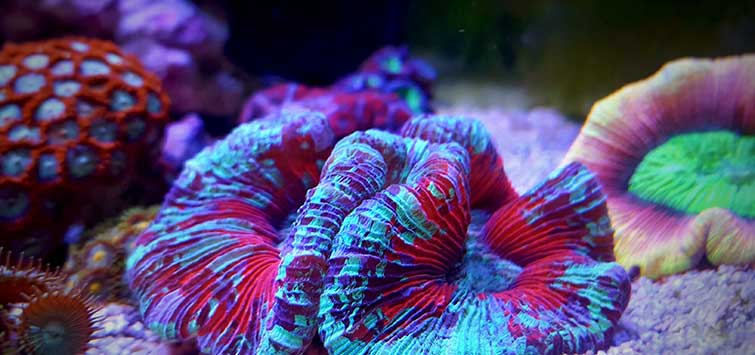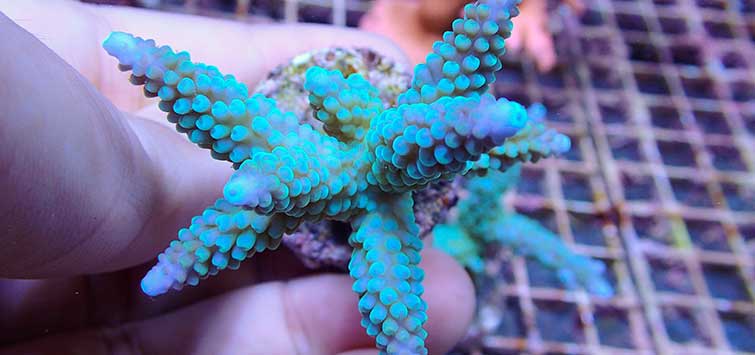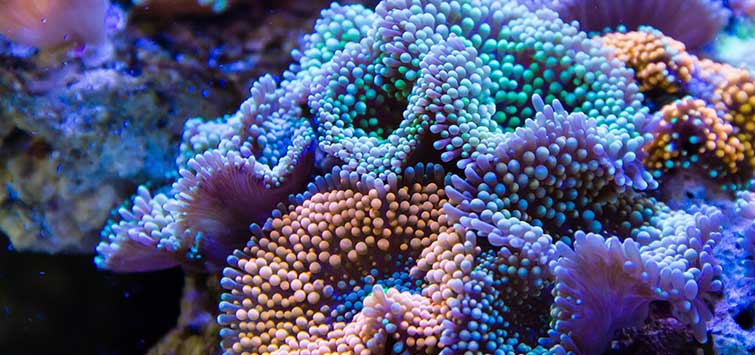The Reefer: Trachyphyllia geoffroyi and the ex-Wellsophyllia radiata
Author: James W. Fatherree, MSc
One of the most common corals offered to reef aquarists is the open brain coral Trachyphyllia geoffroyi, and for as long as I’ve been in the hobby, I’ve seen occasionally offered specimens of a different open brain coral called “wellsophyllia,” a.k.a. the Pacific rose coral. However, as it turns out, this less common open brain, which has long been given the name Wellsophyllia radiata, is actually just a form of T. geoffroyi. Yep, they’re really the same species, and this month I’ll explain how two corals have become one, and give you some care and shopping tips for them/it.
A Tale of Two Corals
T. geoffroyi
First of all, the “regular” open brain, which has always been called T. geoffroyi, has a skeleton that usually has a cone-shaped base, which typically develops into something of a figure-eight shape as they get bigger. These most commonly come in various mixes of fluorescent shades of green and red, with some being almost entirely green, others being almost entirely red, and many that are something in between.
When it comes to common names, specimens that are predominantly green are accordingly called green open brains, while those that are predominantly red are called red open brains. Still, they can sometimes come in other forms, being perfectly round to very elongated, and may even have more of a clover-leaf or convoluted shape with several prominent lobes. They can also come in shades and mixes of brownish, pinkish, or even bluish colors, as well. So you can see that there can actually be a good deal of variability in their appearances.
Wellsophyllia
Likewise, wellsophyllia also typically comes in a range of greens and reds. However, they’re always distinctly round in form and have a flattened bottom rather than a cone-shaped one. While I couldn’t tell you where I got this information from anymore, at some point in the past it was thought that W. radiata also lived on/was collected from hard bottoms in deeper waters, while T. geoffroyi lived in shallower, soft-bottomed environments. Thus, it was thought that the two corals were not just separate species, but were actually members of two separate genera, Trachyphyllia and Wellsophyllia.
Not That Different
This idea went away though, as coral experts eventually decided that these apparently different corals really weren’t that different after all, and that’s how Wellsophyllia radiata became Trachyphyllia geoffroyi. If you look in older coral books you’ll find both of them, but you’ll no longer find W. radiata in coral biology/identification books such as Veron (2000).
On top of that, it has also been observed that both of these corals are sometimes found living side by side in the same environment, and that there’s a continuum of shapes that spans the variety of forms exhibited by the “regular” open brains and the round ones that were always called wellsophyllia (Borneman, 2002). So, for a few years now they’ve all been called Trachyphyllia geoffroyi and are apparently nothing more than different-looking forms of the same coral, which are referred to as morphotypes (morph means “shape” or “form”). However, I still see occasional specimens being offered at a retail shops or online that are called wellsophyllia anyway.
With that covered, I’ll call all of them “open brain corals” from here on out and get on with a discussion of the coral itself, as well as correct a couple of inaccuracies and supply some care and shopping information.
Lighting
For as long as I can remember it was thought that the different color schemes of these corals had something to do with the differences in environmental conditions where they lived. The bright green varieties were supposedly collected in shallower waters, with the prevalence of green pigments being an adaptation to living under bright sunlight. Conversely, the red specimens supposedly lived at greater depths and/or cloudier waters, where light intensity is decreased.
Ideal Conditions
It is true that specimens are found in a wide range of environments, but as it turns out, most of them (at least those coming from Indonesia) are actually collected at depths of around 100 feet, which is fairly deep for corals. In addition, green open brains and red open brains can also be found living side by side in some of these environments where they are collected, under identical conditions (Borneman 2002). So this obviously negates the idea that green specimens live under bright light while red ones live under lesser lighting.
Apparently they can both do just fine under the same conditions, and the notion that a hobbyist must provide more light for a green specimen than a red one is now defunct. Really, as best as I can tell, they can all do well under any lighting system that would be considered suitable for keeping corals. They aren’t picky at all.
Light-Shocking
However, the one thing I do have to warn against for sure is the possibility of “light-shocking” a specimen upon introduction to your tank. Any of them can thrive under intense lighting if given an extended adjustment period, but you never want to buy one and then immediately place it right under a metal halide lamp, or anything else of similar intensity. Instead, you should keep a specimen under dimmer conditions and slowly give them time to adapt to brighter light.
This can be done by simply placing them at the bottom of a deeper tank and then moving them up higher in steps over a couple of weeks if you choose to keep them off the bottom. Or you can use a few sheets of screening material placed between the lights and the coral to block out some of the light, and then remove the sheets one at a time to slowly increase the amount of light that hits the coral.
Substrate
Another myth is that open brain corals must be placed on a sandy or even muddy substrate. This is indeed what they are typically found living on in the wild, but that doesn’t mean it’s required in tanks. For several years in the 1990s when I was first getting into reef aquariums, I only set tanks up with bare bottoms and live rock, as did essentially every other reef keeper in the hobby. So there was no sandy substrate in use, and certainly no muddy ones.
However, during those same years, hobbyists were able to keep open brains directly on the glass bottoms of tanks or placed on the live rock without any issues. Regardless of where they’re found in the wild, they seem to be able to thrive in tanks regardless of what surface they are placed on, as long as other conditions are satisfactory. Still, if you do have a sand-covered bottom (all of my tanks do these days), I’d say put an open brain on it anyway to better mimic their natural habitat.
Water Movement
Okay, so their lighting and substrate needs are flexible, but one thing I can tell you for sure is that open brains do not like being blasted by a strong current. The environments they’re found in have weak to moderate currents at best, and they will not expand their fleshy tissues if it’s any stronger.
Their skeletons actually have numerous thin, blade-like ridges on them, and they can expand their soft fleshy bodies to such a degree that any really strong currents could actually cause them to cut their own tissues on their skeleton. So you should be sure that water does move over and around them in a tank, but not to the point that they keep their flesh retracted into their skeleton or risk being ripped up.
Nutrition
It’s a given that water quality should be up to par, but one thing you might not think of is giving an open brain a good meal every once in a while. Providing them with an occasional serving of some sort of appropriate meaty food (like brine shrimp, small bits of clam meat, etc.) will bring on their feeding responses, and that can be pretty neat to watch. Giving them food lets you see how different they can look at times, which is something you probably won’t ever see unless you hand feed them. Of course, it will help to ensure that they’re getting all the nutrients they need, too.
Feeding
The easiest way to do this is to turn off all the pumps, filters, etc. and then use a big syringe (without the needle) or a turkey baster to squirt a very small shot of food—or even just some of the water carrying its odor—over a coral’s body, near the mouth(s). Then, after a few minutes, the coral will react when it detects the presence of food in the area. The mouth(s) will go from being a small slit to what looks like swollen, puckered lips. The short feeding tentacles, which are usually hidden under a flap of tissue, will also extend in an effort to capture any food bits that come their way.
Once prepared, you can use the syringe or baster to squirt more food onto their tentacles and watch them slowly grab and ingest whatever is offered. This may sound like a bit of a hassle, but these corals eat so slowly that you’d be amazed that they manage in the wild, as it can take up to several minutes for them to completely ingest even small bits of food like a few brine shrimp.
Feeding Frequency
A common question on this topic is how often you should feed an open brain coral, and that’s not an easy one to answer. Some folks say they need to be fed several times a week, others say a couple of times a week, and some say they only need to be fed every once in a while.
I think it’s really going to depend on the environment they’re in for the most part. If a specimen is getting lots of light, it won’t be as dependent on other food sources. Conversely, if the lights are dimmer, it’ll likely need more food. If it’s in a bare-bottom tank with no sort of food being added, it’ll likely need to be fed more. Or, if it’s in a tank that’s set up with a food-producing deep sand bed, it may get all the food it needs without any extra help from you. Thus, you’ll have to be the judge of what is required as a minimum, depending on your own situation.
They do like to eat, though, regardless of the situation, so even if they are getting everything they need to survive without your assistance, I still say offer them something now and then. If for no other reason, it’s neat to watch. Conversely, if you are feeding frequently and start overdoing it they’ll simply reject the food and/or will spit out nasty looking gobs of mucus and undigested food later. So if you pay attention and keep a good watch on a specimen long enough, you should be able to figure out how much to provide it and how often.
Shopping Tips and Health Issues
When it comes to things to watch out for when shopping, open brain corals sometimes suffer from a few problems that commonly affect many other sorts of stony corals. As is the case with other particularly fleshy corals, the first thing to look for is good expansion. While shopping, if you come across an open brain that is tightly retracted into its skeleton, pass it up, as it may be unhappy for some reason. It doesn’t necessarily mean it will die, but you should go for another specimen that looks better and is well expanded if possible.
Failure to Expand
A failure to expand can be something of a riddle at times when it comes to open brains though, as they’ve been known to look very healthy for long periods and then just stop expanding one day. Sometimes it may be due to a sudden change in lighting intensity, like moving them from the wild to the store to your tank, or changing your bulbs. However, at other times it may be related to adding a new coral to your tank that gives off noxious chemicals, or it may be related to nothing you can put your finger on at all.
If this happens in your tank, the best thing you can do is try to figure out what may have changed and then correct the situation. I’ll warn you, though, that sometimes nothing seems to work at all, and a specimen won’t respond to anything you may try. Fortunately, if all conditions are suitable, eventually they typically recover fully, though (again) without any obvious reason.
Bleaching
Open brain corals will also bleach at times, and you should obviously avoid buying anything of any species that has bleached. Still, if it happens in your tank after you’ve already purchased a seemingly healthy specimen, the condition can sometimes be successfully reversed if appropriate action is taken (for my two-part series on bleaching, including its causes and cures, see “The Reefer,” TFH January 2007 and February 2007).
Tissue Damage and Recession
Lastly, we get to tissue damage and recession. As mentioned, open brain corals have sharp ridges on their skeletons, and when specimens are shipped from place to place they sometimes get damaged in the process when the tissue rubs and bumps against these ridges. This can happen even when a specimen’s tissue is fully retracted. So keep a sharp lookout for any apparent damage to the fleshy part of a specimen before buying one.
If the tissue is damaged in such a way, it will oftentimes begin to recede and sort of rot and or peel away from the area of the injury. In bad cases, this can eventually lead to the death of a specimen, although if kept under good conditions it can be reversible. Unfortunately, this sort of tissue recession can also happen at other times, when there has been no physical injury to a coral. While the exact cause isn’t known, my guess is that it’s a reaction to poor water quality and/or a lack of nutrients.
If it happens, be sure to check your water quality. Calcium and alkalinity may need adjustment and/or phosphate concentrations may be high enough to inhibit growth, etc. Be sure you are providing enough light and/or food, then hope for the best.
Despite these issues, open brain corals are categorically some of the hardiest corals you can choose from, and they’re usually quite attractive, too. So I highly recommend them to anyone that has adequate lighting and good water quality. I’ve had at least one in every reef tank I’ve ever owned or set up for someone else.
References
Borneman, E. H. 2002. “Do you know where your corals are coming from? Ecological information for aquarists from coral collection areas in Indonesia.” Advanced Aquarist’s Online Magazine: www.advancedaquarist.com/issues/mar2002/feature.htm.
Borneman, E. H. 2002. Personal communication.
Veron, J. E. N. 2000. Corals of the World. Australian Institute of Marine Science, Townsville, Australia. vol.3, pp.270–273.

.png?h=595&iar=0&w=2781&hash=5FD5E69473BCC22199FBFA2FB71B6033)



